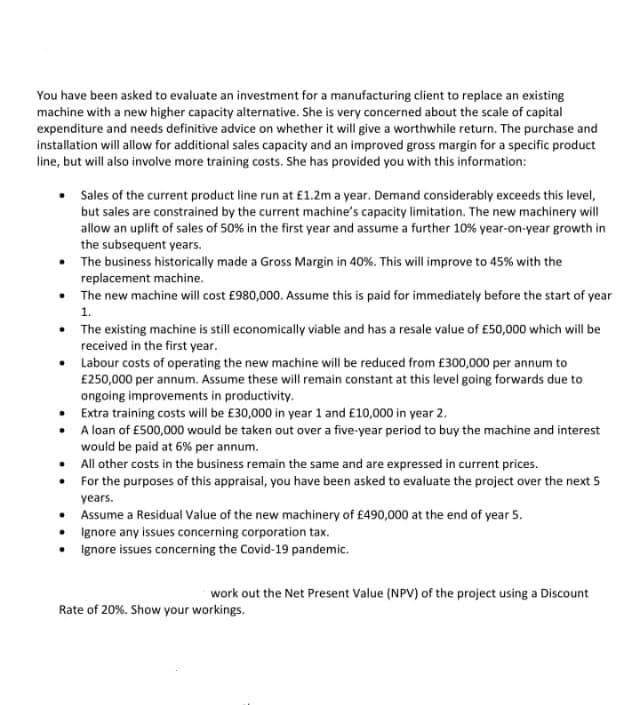machine expendit nstallatic ine, but
Essentials of Business Analytics (MindTap Course List)
2nd Edition
ISBN:9781305627734
Author:Jeffrey D. Camm, James J. Cochran, Michael J. Fry, Jeffrey W. Ohlmann, David R. Anderson
Publisher:Jeffrey D. Camm, James J. Cochran, Michael J. Fry, Jeffrey W. Ohlmann, David R. Anderson
Chapter12: Integer Linear Optimization_models
Section: Chapter Questions
Problem 3P: Spencer Enterprises is attempting to choose among a series of new investment alternatives. The...
Related questions
Question

Transcribed Image Text:You have been asked to evaluate an investment for a manufacturing client to replace an existing
machine with a new higher capacity alternative. She is very concerned about the scale of capital
expenditure and needs definitive advice on whether it will give a worthwhile return. The purchase and
installation will allow for additional sales capacity and an improved gross margin for a specific product
line, but will also involve more training costs. She has provided you with this information:
Sales of the current product line run at £1.2m a year. Demand considerably exceeds this level,
but sales are constrained by the current machine's capacity limitation. The new machinery will
allow an uplift of sales of 50% in the first year and assume a further 10% year-on-year growth in
the subsequent years.
The business historically made a Gross Margin in 40%. This will improve to 45% with the
replacement machine.
• The new machine will cost £980,000. Assume this is paid for immediately before the start of year
1.
• The existing machine is still economically viable and has a resale value of £50,000 which will be
received in the first year.
• Labour costs of operating the new machine will be reduced from £300,000 per annum to
£250,000 per annum. Assume these will remain constant at this level going forwards due to
ongoing improvements in productivity.
Extra training costs will be £30,000 in year 1 and £10,000 in year 2.
A loan of £500,000 would be taken out over a five-year period to buy the machine and interest
would be paid at 6% per annum.
• All other costs in the business remain the same and are expressed in current prices.
• For the purposes of this appraisal, you have been asked to evaluate the project over the next 5
years.
Assume a Residual Value of the new machinery of £490,000 at the end of year 5.
Ignore any issues concerning corporation tax.
Ignore issues concerning the Covid-19 pandemic.
work out the Net Present Value (NPV) of the project using a Discount
Rate of 20%. Show your workings.
Expert Solution
This question has been solved!
Explore an expertly crafted, step-by-step solution for a thorough understanding of key concepts.
Step by step
Solved in 3 steps

Knowledge Booster
Learn more about
Need a deep-dive on the concept behind this application? Look no further. Learn more about this topic, accounting and related others by exploring similar questions and additional content below.Recommended textbooks for you

Essentials of Business Analytics (MindTap Course …
Statistics
ISBN:
9781305627734
Author:
Jeffrey D. Camm, James J. Cochran, Michael J. Fry, Jeffrey W. Ohlmann, David R. Anderson
Publisher:
Cengage Learning

Principles of Accounting Volume 2
Accounting
ISBN:
9781947172609
Author:
OpenStax
Publisher:
OpenStax College

Cornerstones of Cost Management (Cornerstones Ser…
Accounting
ISBN:
9781305970663
Author:
Don R. Hansen, Maryanne M. Mowen
Publisher:
Cengage Learning

Essentials of Business Analytics (MindTap Course …
Statistics
ISBN:
9781305627734
Author:
Jeffrey D. Camm, James J. Cochran, Michael J. Fry, Jeffrey W. Ohlmann, David R. Anderson
Publisher:
Cengage Learning

Principles of Accounting Volume 2
Accounting
ISBN:
9781947172609
Author:
OpenStax
Publisher:
OpenStax College

Cornerstones of Cost Management (Cornerstones Ser…
Accounting
ISBN:
9781305970663
Author:
Don R. Hansen, Maryanne M. Mowen
Publisher:
Cengage Learning

Managerial Accounting: The Cornerstone of Busines…
Accounting
ISBN:
9781337115773
Author:
Maryanne M. Mowen, Don R. Hansen, Dan L. Heitger
Publisher:
Cengage Learning

Excel Applications for Accounting Principles
Accounting
ISBN:
9781111581565
Author:
Gaylord N. Smith
Publisher:
Cengage Learning

Financial Reporting, Financial Statement Analysis…
Finance
ISBN:
9781285190907
Author:
James M. Wahlen, Stephen P. Baginski, Mark Bradshaw
Publisher:
Cengage Learning